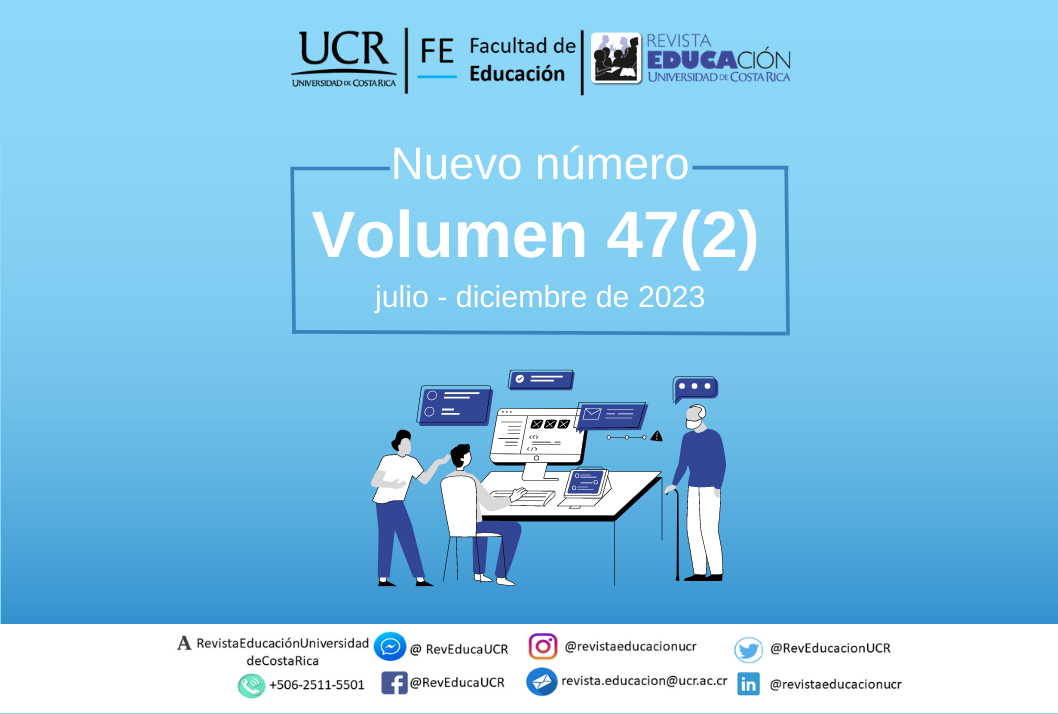Resumen
El objetivo de esta investigación fue analizar la percepción de la autoimagen física y social de dos grupos de noveno año, uno de un colegio público y otro de un colegio privado, ambos de la provincia de San José. Para esto, se utilizó el paradigma positivista, con una metodología de carácter cuantitativo con un alcance descriptivo. Dado que este estudio buscó medir la autoimagen física y social, se diseñó un cuestionario para la recolección de los datos y se aplicó a la población estudiantil en estudio durante una sesión de orientación colectiva. En cuanto a los resultados, se analizaron de manera descriptiva con frecuencias y porcentajes. Las variables del estudio corresponden a la autoimagen física y social de la persona adolescente. En cuanto a los principales resultados referidos a la autoimagen física, un hallazgo importante es que un alto porcentaje del estudiantado de ambas instituciones educativas manifestó estar conforme con su físico. No obstante, en relación con la autoimagen social, se halló que un porcentaje significativo del estudiantado señaló la burla de los pares como un factor desfavorable, generando consecuencias en la autoimagen social, provocadas por los comentarios negativos e insultos que se pueden relacionar con conflictos, problemas en las relaciones interpersonales y tipos de acoso escolar.
Citas
Barrantes, R. (2005). Investigación: un camino al conocimiento, un enfoque cualitativo y cuantitativo. UNED.
Buitrago, R. y Sáenz, N. (2021). Autoimagen, Autoconcepto y Autoestima. Perspectivas Emocionales para el Contexto Escolar.
Educación y Ciencia, (24), e 12759. https://doi.org/10.19053/0120-7105.eyc.2021.25.e12759
Calvache, D. (2018). La autoimagen en la adolescencia reforzamiento del amor propio. Universidad Javeriana de Cali. https://core.ac.uk/download/pdf/161401819.pdf
Campos, D. C. y Trautner, H. M. (2004). El hombre y la mujer ideal según adolescentes en Costa Rica y Alemania. Revista Latinoamericana de Psicología, 36(3), 471-482. https://www.redalyc.org/pdf/805/80536308.pdf
Cohen, S. Esterkind, A. E., Lacunza, B. A., Caballero, V. S. y Martinenghi, C. (2011). Habilidades sociales y contexto sociocultural. Un estudio con adolescentes a través del BAS-3. Revista Iberoamericana de Diagnóstico y Evaluación, 1(29), 167-185. https://www.redalyc.org/pdf/4596/459645441010.pdf
De Mézerville, G. (2004). Ejes de salud mental. Los procesos de autoestima, dar y recibir afecto y adaptación al estrés. Trillas.
Fernández, L. G. y Azofeifa, E. G. (2007). Relación entre la satisfacción con la imagen corporal autoconcepto físico, índice de masa corporal y factores socioculturales en mujeres adolescentes costarricenses. PENSAR EN MOVIMIENTO: Revista de Ciencias del Ejercicio y la Salud, 5(1), 9-18. https://revistas.ucr.ac.cr/index.php/pem/article/view/356
Garaigordobil, M. (2000). Intervención psicológica con adolescentes. Pirámide.
García, N. I. (2004). Trastornos de la conducta alimentaria en adolescentes de ambos sexos con y sin diabetes mellitus tipo 1. [tesis doctoral, inédita]. Universidad de Barcelona. http://hdl.handle.net/10803/5436
Gimenez, P., Correché, M. S. y Rivarola, M. F. (2013). Autoestima e Imagen Corporal. Estrategias de intervención psicológica para mejorar el bienestar psicológico en pre- adolescentes en una escuela de la ciudad de San Luis, Argentina. Fundamentos en Humanidades, 14(27), 83-93 Universidad Nacional de San Luis. https://www.redalyc.org/pdf/184/18440029004.pdf
Gómez, A., Sánchez, B. J., Molina, J. y Bazaco, M. J. (2017). Violencia Escolar y Autoimagen en Adolescentes de la Región de Murcia (España). Revista Internacional de Medicina y Ciencias de la Actividad Física y del
Deporte, 17(68), 677-692. https://www.redalyc.org/pdf/542/54254647007.pdf
Hernández, R., Fernández, C. y Baptista, P. (2010). Metodología de la Investigación. Editorial McGraw-Hill.
James, H. y McMillan, S. (2005). Investigación Educativa: una introducción conceptual. Pearson Educación.
Krauskopf, D. (2014). Adolescencia y Educación. Editorial UNED.
Krauskopf, D. (2018). Adolescencia y Educación. Editorial UNED.
Llamazares, A. y Urbano, A. (2020). Autoestima y habilidades sociales en adolescentes: el papel de variables familiares y escolares. Pulso: revista de educación, (43), 99-117. https://dialnet.unirioja.es/servlet/articulo?codigo=7803963
Milicic, N. (2015). Desarrollar la autoestima de nuestros hijos: tarea familiar imprescindible. https://docplayer.es/23715480-Desarrollar-la-autoestima-de-nuestros-hijos-tarea-familiar-imprescindible.html
Monroy, J., Velázquez, G. y Galindo, E. (2020, 26-28 de setiembre). Niveles de autoestima, autoconcepto y autoimagen en adolescentes de Iztapalapa. [Ponencia]. Debates en Evaluación y Currículum. Congreso Internacional de Educación: Currículum. Universidad Nacional Autónoma de TLAXCALA, México. https://docplayer.es/226196997-Debates-en-evaluacionycurriculum- congreso-internacional-de-educacion-curriculum-2019-ano-5-no-5septiem-bre -de-2019-a-agosto-de-2020.html
Ibarra, A. y Jacobo, H. M. (2017). La evolución de la concepción de amistad a través del concepto de compañero y amigo y la trayectoria del autoconcepto social durante la adolescencia. Revista de Educación y Diversidad, 42,13-23. https://www.cucs.udg.mx/revistas/edu_desarrollo/anteriores/42/42_Ibarra.pdf
Ismail, N. A. H. y Tekke, M. (2015). Rediscovering Rogers’s self-theory and personality [Redescubriendo la teoría del yo y la personalidad de Rogers]. Journal of Educational, Health and Community Psychology, 4(3), 28-36. https://www.researchgate.net/publication/286456614_Rediscovering_Rogers%27s_Self_Theory_and_Personality
Organización Mundial de la Salud. (2003). Departamento de Salud Mental y Dependencia de Substancias. Atención de niños y adolescentes con trastornos mentales. OMS.
Papalia, D., Wendkos, S. y Duskin, R. (2004). Desarrollo Humano. Editorial McGraw-Hill Interamericana.
Reina, M. C., Oliva, A. y Parra, A. (2010). Percepciones de autoevaluación: Autoestima, autoeficacia y satisfacción vital en la adolescencia. Psychology, Society & Education, 2(1), 55-69. http://repositorio.ual.es/handle/10835/2913
Salazar, Z. (2008). Adolescencia e Imagen Corporal en la Época de la Delgadez. Reflexiones, 87(2), 67-80. https://revistas.ucr.ac.cr/index.php/reflexiones/article/view/11496
Santrock, J. (2004). Psicología del desarrollo en la adolescencia. (9a ed.). McGraw-Hill. https://toaz.info/doc-view-2
Solum, B. (2001). Adolescencia y Juventud en América Latina. LUR.
##plugins.facebook.comentarios##

Esta obra está bajo una licencia internacional Creative Commons Reconocimiento-NoComercial-SinObraDerivada 3.0.
Derechos de autor 2023 Revista Educación







